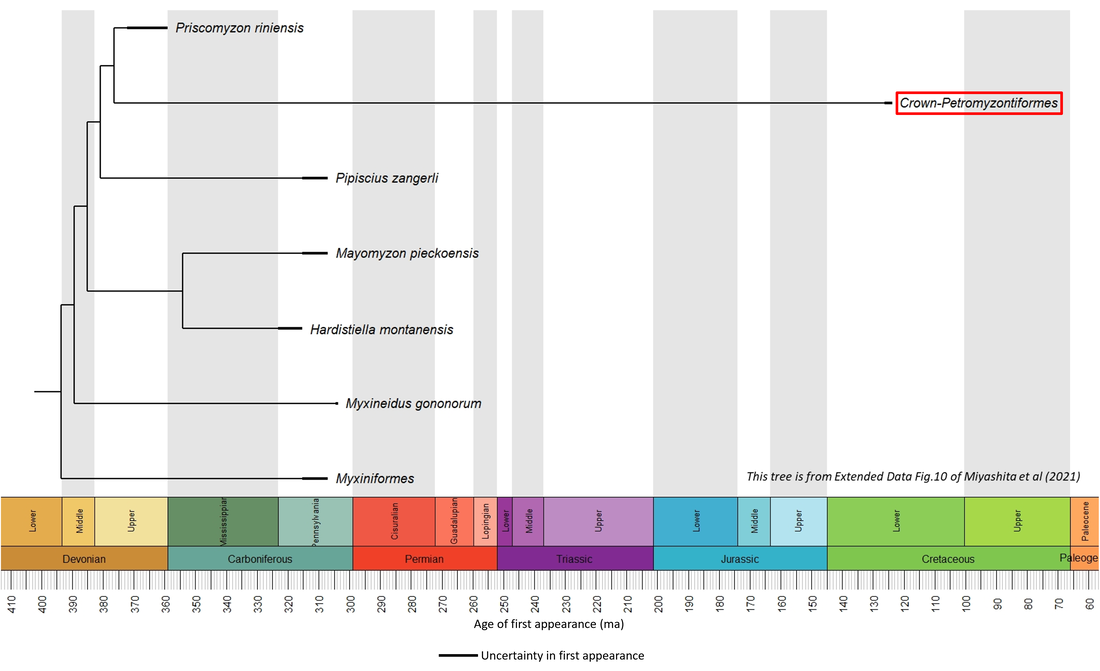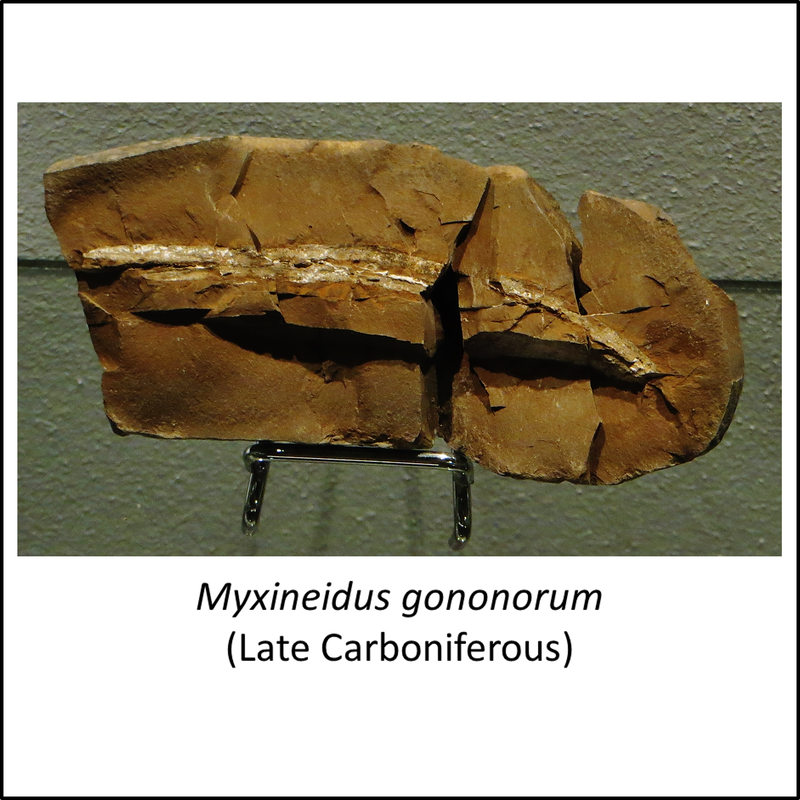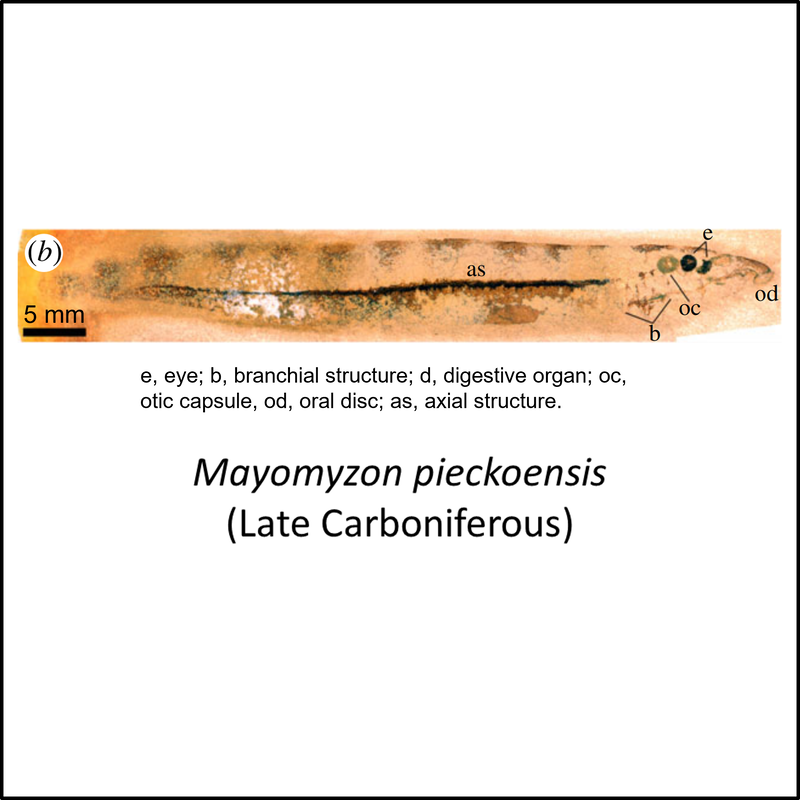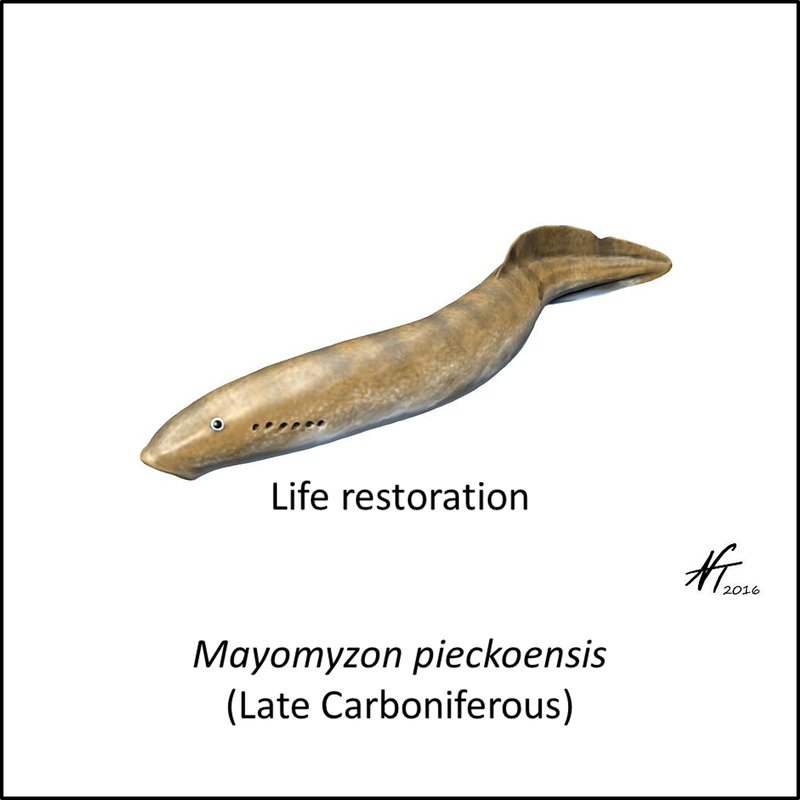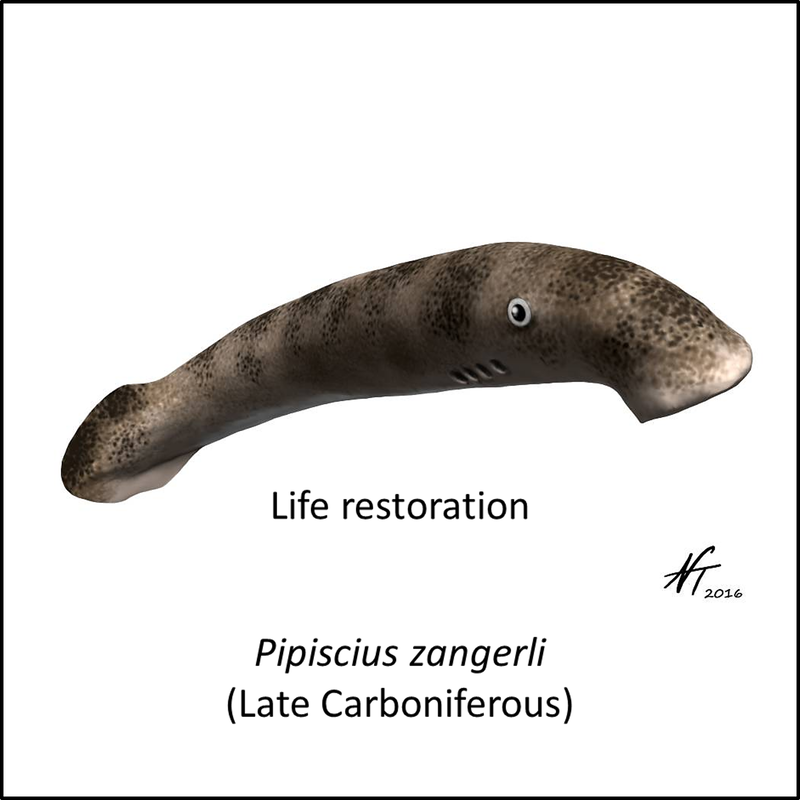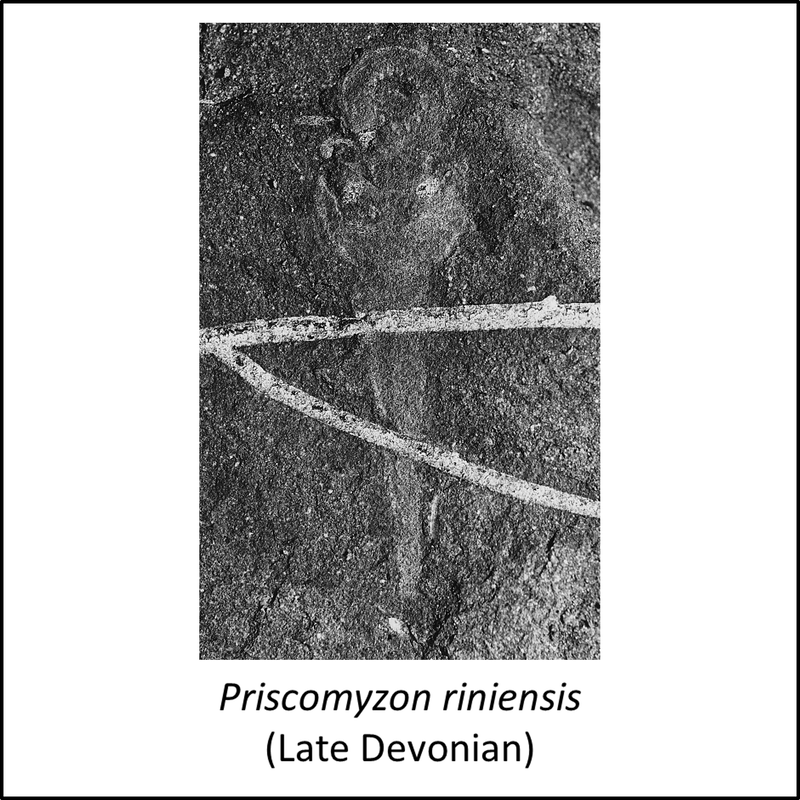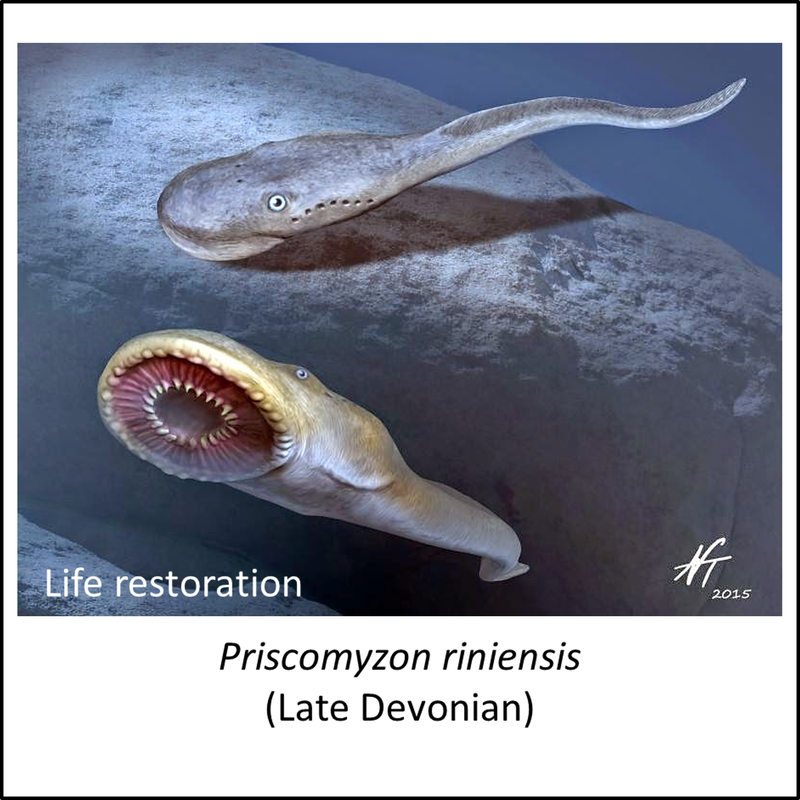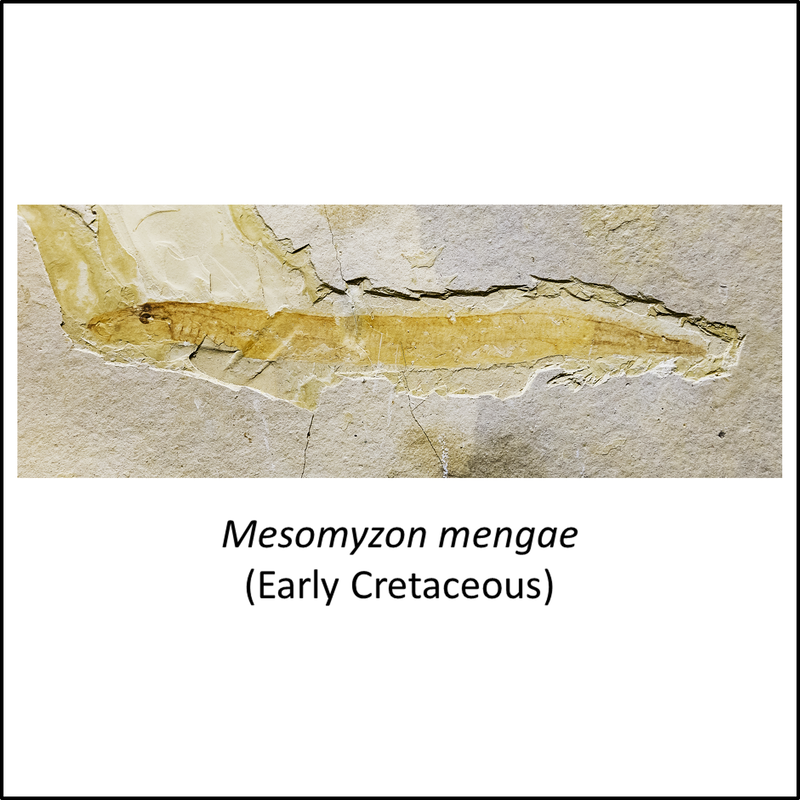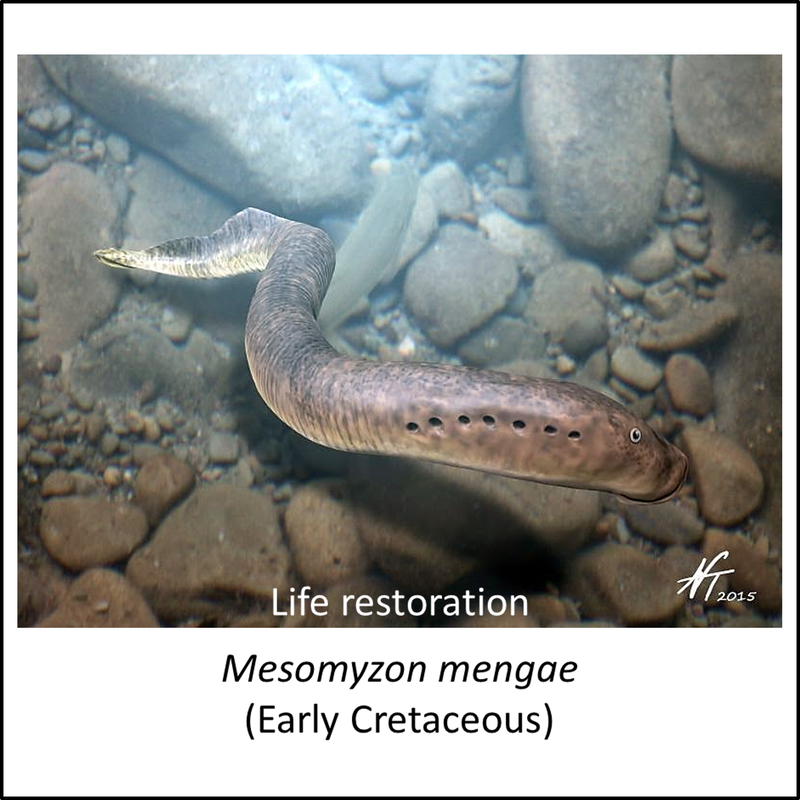This page deals with the stem group of the lampreys (Order Petromyzontiformes, clade Cyclostomata), an extant group of jawless fishes that live in coastal and fresh waters and are found in temperate regions around the world, except Africa (Encyclopedia Britannica). Around 43 living species are known.
On the basis of phylogenetic analysis of morphological, several stem-group lampreys have been identified by Miyashita et al (2021), as illustrated in the following phylogenetic time tree:
On the basis of phylogenetic analysis of morphological, several stem-group lampreys have been identified by Miyashita et al (2021), as illustrated in the following phylogenetic time tree:
Figure 1. Phylogenetic time tree of the Petromyzontiformes stem group
The earliest known fossil representative of the lamprey stem group is Priscomyzon riniensis. It was found in the Late Devonian (Famennian) Witpoort Formation at Waterloo Farm, Grahamstown, South Africa (Gess et al, 2006; Benton et al, 2015). This species, together with most of the other genera shown in the above tree, is illustrated below (click on any image for a larger view):
Figure 2. Images of stem-group lampreys
The above images are placed in left-to-right order from the most basal to the furthest crownward, but no obvious trends can be seen. However, an oral disk can be seen in Mayomyzon pieckoensis and Priscomyzon riniensis, indicating that the annular cartilage (synapomorphy 2 in the list above) had developed by the time those species appeared. With respect to the transition to the crown group, none of these stem species appear to have the separate anterior and posterior dorsal fins characteristic of crown lampreys (Gess et al, 2006).
The oldest known member of the crown-group lampreys is Mesomyzon mengae, described from the Early Cretaceous (Late Barremian to Early Aptian) Yixian Formation in Ningcheng County , Inner Mongolia, China (Chang et al, 2006; Miyashita et al, 2021). A fossil and a life restoration are shown below (for larger view, click on image):
The oldest known member of the crown-group lampreys is Mesomyzon mengae, described from the Early Cretaceous (Late Barremian to Early Aptian) Yixian Formation in Ningcheng County , Inner Mongolia, China (Chang et al, 2006; Miyashita et al, 2021). A fossil and a life restoration are shown below (for larger view, click on image):
Figure 3. Fossil and life restoration of oldest crown-group lamprey
The transition from the stem-Cyclostomata to the lamprey crown group, represented by the fossils illustrated in Figures 2 and 3, took place over a period of around 240 million years, from the Late Devonian to the Early Cretaceous (Figure 1).
References
Benton, M. J., Donoghue, P. C., Asher, R. J., Friedman, M., Near, T. J., & Vinther, J. (2015). Constraints on the timescale of animal evolutionary history. Palaeontologia Electronica, 18(1), 1-106.
Chang, M. M., Zhang, J., & Miao, D. (2006). A lamprey from the Cretaceous Jehol biota of China. Nature, 441(7096), 972-974.
Gess, R. W., Coates, M. I., & Rubidge, B. S. (2006). A lamprey from the Devonian period of South Africa. Nature, 443(7114), 981-984.
Miyashita, T., Coates, M. I., Farrar, R., Larson, P., Manning, P. L., Wogelius, R. A., ... & Currie, P. J. (2019). Hagfish from the Cretaceous Tethys Sea and a reconciliation of the morphological–molecular conflict in early vertebrate phylogeny. Proceedings of the National Academy of Sciences, 116(6), 2146-2151.
Miyashita, T., Gess, R. W., Tietjen, K., & Coates, M. I. (2021). Non-ammocoete larvae of Palaeozoic stem lampreys. Nature, 591(7850), 408-412.
Chang, M. M., Zhang, J., & Miao, D. (2006). A lamprey from the Cretaceous Jehol biota of China. Nature, 441(7096), 972-974.
Gess, R. W., Coates, M. I., & Rubidge, B. S. (2006). A lamprey from the Devonian period of South Africa. Nature, 443(7114), 981-984.
Miyashita, T., Coates, M. I., Farrar, R., Larson, P., Manning, P. L., Wogelius, R. A., ... & Currie, P. J. (2019). Hagfish from the Cretaceous Tethys Sea and a reconciliation of the morphological–molecular conflict in early vertebrate phylogeny. Proceedings of the National Academy of Sciences, 116(6), 2146-2151.
Miyashita, T., Gess, R. W., Tietjen, K., & Coates, M. I. (2021). Non-ammocoete larvae of Palaeozoic stem lampreys. Nature, 591(7850), 408-412.
Image credits - Lampreys
- Header: Ohio lamprey (Ichthyomyzon bdellium): Andrew M. Turner, licensed under a Creative Commons Attribution-NonCommercial-ShareAlike 3.0 Unported License
- Figure 2 (Myxineidus gononorum): Ghedoghedo, CC BY-SA 4.0 <https://creativecommons.org/licenses/by-sa/4.0>, via Wikimedia Commons
- Figure 2 (fossil of Mayomyzon pieckoensis): From Open Access article Gabbott, S. E., Donoghue, P. C., Sansom, R. S., Vinther, J., Dolocan, A., & Purnell, M. A. (2016). Pigmented anatomy in Carboniferous cyclostomes and the evolution of the vertebrate eye. Proceedings of the Royal Society B: Biological Sciences, 283(1836), 20161151.
- Figure 2 (life restoration of Mayomyzon pieckoensis): Nobu Tamura under Creative Commons Attribution- ShareAlike (CC BY-SA) license
- Figure 2 (Pipiscius zangerli): Nobu Tamura under Creative Commons Attribution- ShareAlike (CC BY-SA) license
- Figure 2 (fossil of Priscomyzon riniensis): Robert Gess, CC BY-SA 3.0 <https://creativecommons.org/licenses/by-sa/3.0>, via Wikimedia Commons
- Figure 2 (life restoration of Priscomyzon riniensis): Nobu Tamura under Creative Commons Attribution- ShareAlike (CC BY-SA) license
- Figure 3 (fossil of Mesomyzon mengae): Tiouraren (Y.-C. Tsai), CC BY-SA 4.0 <https://creativecommons.org/licenses/by-sa/4.0>, via Wikimedia Commons
- Figure 3 (life restoration of Mesomyzon mengae): Nobu Tamura under Creative Commons Attribution- ShareAlike (CC BY-SA) license
